June 8, 2007
Air Date: June 8, 2007
FULL SHOW
SEGMENTS
Fuel Economy Fight
/ Jeff YoungView the page for this story
After decades of idling in neutral, U.S. auto fuel efficiency standards could soon kick into high gear. Congress appears poised to raise requirements forcing automakers to offer more high-mileage cars and trucks. But Detroit is betting on powerful allies on Capitol Hill to put up some roadblocks. Living on Earth's Jeff Young reports from Washington. (05:30)
Is Small Beautiful?
View the page for this story
Nanotechnology, the manipulation of matter on the atomic level, is in products from sunscreen to washing machines, but the government has no specific regulations for this emerging field. Living on Earth host Bruce Gellerman talks with Dr. Vicki Colvin, director of the Center for Biological and Environmental Nanotechnology at Rice University, to learn more about why size matters when it comes to nanoparticles. (06:30)
Cancer-Causing Chemicals
View the page for this story
A recent meta-study published by the American Cancer Society suggests that over 200 chemicals found in everyday products cause breast cancer in animals. Devra Lee Davis is director of the Center for Environmental Oncology at the University of Pittsburgh Cancer Institute. Dr. Davis tells Living on Earth’s Steve Curwood about the evidence that links environmental factors to breast cancer and how reducing exposure can help prevent women from getting the disease. (08:00)
REACHing for Regs
View the page for this story
A new European law called REACH goes into effect requiring chemical companies to submit data for 30,000 chemicals, proving their safety. But will the U.S. follow? (01:45)
Google Earth Finds its Voice
View the page for this story
Sounds of a California sunrise, anemones singing, a busy Lisbon street…these are some of the recordings Bernie Krause has made during his 40 year career. Krause recently teamed up with Google Earth to add this and other audio to enhance the online satellite views of the world. He spoke with host Bruce Gellerman. (08:00)
Cosmic Quandaries
View the page for this story
Space is full of bizarre objects and mysterious forces, but perhaps none is more puzzling than something called "dark matter." Living on Earth host Bruce Gellerman talks with Neil deGrasse Tyson, director of New York’s Hayden Planetarium, about the nature of dark matter and about a new planet recently discovered outside our solar system that might host life. (08:15)
Geophonic Music
/ Ian GrayView the page for this story
We've heard a lot about climate change in the news over the past few years, but how many of us have actually heard climate change itself? Composer Arvid Tomayako-Peters takes listeners on a musical voyage back through five million years of Earth's climate history. (07:30)
This week's EarthEar selection
listen /
download
Moans and groans of colliding ice sheets near the Canadian Abyssal Plain.
Show Credits and Funders
Show Transcript
HOST: Bruce Gellerman
GUEST: Professor Vicki Colvin, Dr.Devra Lee Davis, Dr. Steve Russel
REPORTER: Jeff Young, Ian Gray
[THEME]
GELLERMAN: From Public Radio International - this is Living on Earth.
[THEME]
GELLERMAN: I’m Bruce Gellerman. Driven to anger, one lawmaker tells Detroit to step on it and increase fuel efficiency in cars, fast.
DORGAN: I think Congress is moving on, and you’re gonna have increased efficiency requirements coming from the Congress. I think the issue is over, I think you’ve lost that issue. I think that your position is yesterday forever.
GELLERMAN: Also, what you can’t see and what’s not being regulated might hurt you.
As nanotechnology gets big, concerns grow about its effects to our health and the environment.
COLVIN: I think what's important is that we let people know what we know and what we don't know because I kinda want to know what risks am I taking. And if they're unknown, I want to know that too.
GELLERMAN: And, making music out of mud. A student mines geological data for sound.
MUSIC: Arvid Tomayko-Peters “Pond Core Metals”
GELLERMAN: These stories and more this week on Living on Earth. Stick around!
[THEME]
[NPR NEWSCAST]
ANNOUNCER: Support for Living on Earth comes from the National Science Foundation and Stonyfield Farm.
[THEME RETURN]
Fuel Economy Fight
GELLERMAN: From the Jennifer and Ted Stanley Studios in Somerville, Massachusetts—this is Living on Earth. I’m Bruce Gellerman, in for Steve Curwood. After sitting in neutral for two decades, fuel efficiency standards for cars and trucks could soon get a jump-start.
For years US automakers have effectively resisted attempts in Congress to increase standards for what’s called CAFE, short for corporate average fuel economy. Now, concerns about high gas prices and global warming are pushing Congress to act. But automakers and their Democratic allies are pushing back. Living on Earth’s Jeff Young tells us some powerful motor city lawmakers want to weaken mileage standards and prevent states from regulating the greenhouse gases coming out of cars.
YOUNG: Thirty-five miles per gallon by the year 2020: That’s the fuel economy standard the US Senate will soon consider. It would be the biggest mileage boost in decades. And it brought the CEOs of Detroit’s Big 3 automakers to Capitol Hill.
General motor’s chief Rick Wagoner told senators at a luncheon that kind of increase could cost thousands of dollars for every car GM makes. Wagoner argued instead for things like more alternative fuels.
WAGONER: We can and we will improve fuel efficiency. We think there are ways to do it that are smarter than just the exclusive reliance on CAFE.
YOUNG: It’s an approach that’s worked for Wagoner in the past. But this year the auto industry’s not getting much traction on the Hill, even among Senators who voted its way in the past, like North Dakota Democrat Byron Dorgan.
DORGAN: I have previously voted against CAFE standards but I just want you to know I think the issue is over, I think you’ve lost that issue. I think your position is yesterday forever.
YOUNG: Senators heaped on the criticism. After that less than appetizing lunch, GM’s
Wagoner told reporters he could see the writing on the wall.
WAGONER: My sense is there will be increases in CAFE so I’m not coming from a good bargaining position to say anything other than I expect that that is going to happen.
YOUNG: But Detroit’s leaders are hoping for some escape clauses in the legislation and they’re counting on some powerful Democrats to provide them. In the Senate that’s Carl Levin of Michigan who argues that CAFE standards discriminate against US automakers, who tend to make more trucks.
LEVIN: It’s perverse. It works against American jobs without a darn bit of benefit to the air.
YOUNG: Levin proposes an alternative with lower mileage targets and more time for the industry to meet them. It would also let automakers avoid efficiency rules if they pledge to use advanced technology. Automakers are also fighting back with a million dollar ad campaign.
AD SOUND: Why can’t they let me make the choice? I’m all for better fuel economy but safety is my top concern.
YOUNG: This radio ad airing in a dozen states dusts off one of the industry’s arguments: that higher miles per gallon means reduced safety.
ANNOUNCER: Contact your senators. Tell them fuel economy is important but we shouldn’t put safety in the back seat.
YOUNG: But a number of recent studies cast doubt on this “blood-on-the-highway” argument. Tom Wenzel is a scientist who studies auto-safety for Lawrence Berkley
National Laboratory. Wenzel co-wrote a new report by the International Council on Clean Transportation summarizing the latest research.
WENZEL: There are many technologies available to improve fuel economy that would have no effect on vehicle safety. So we shouldn’t let the old argument that high fuel economy vehicles necessarily mean less safe vehicles. We shouldn’t let that stand in the way of increasing the fuel economy of the new vehicle fleet.
YOUNG: Recent opinion polls show strong support for boosting mileage and acting on global warming. A dozen states have responded with proposed rules limiting greenhouse gas emissions from autos. California led the way and got a big boost from a landmark Supreme Court ruling this spring in the case Massachusetts versus EPA. The Justices said the Clean Air Act gives the government authority to regulate those tailpipe emissions. In an unexpected twist in the fuel efficiency debate, a top lawmaker is now trying to block that Supreme Court ruling and those states that would use it to control global warming pollution.
DINGELL: We need one good strong regulator. We don’t need a whole lot of people messing around.
YOUNG: That’s Congressman John Dingell of Michigan--one of the most senior
Democrats in Congress, chair of the powerful House Energy Committee, and a staunch defender of the auto industry in his home state. Dingell says the Supreme Court decision will bring a regulatory mess.
DINGELL: The Supreme court didn’t do anything constructive. All it did was say that the Congress had not done a good job in drafting the legislation. Let me remind you, I wrote the clean air law. I know what the congress intended. We are returning to what congress intended and to a system which, in fact, will work.
YOUNG: The attorneys general of 14 states oppose Dingell’s proposal, as does the second highest-ranking Democrat in the House Energy Committee, Ed Markey of
Massachusetts.
MARKEY: This bill is cutting the legs out from under the states just as they are starting to sprint forward on carbon pollution regulation.
YOUNG: House Speaker Nancy Pelosi of California also says she could not support a bill that blocks states from regulating greenhouse gases from autos. That could set up a battle between two of the most powerful Democratic leaders, Pelosi and Dingell. It also means the road to higher fuel standards has a few bumps ahead.
For Living on Earth I’m Jeff Young in Washington.
Related links:
- International Council on Clean Transportation report on fuel economy and auto safety
- Union of Concerned Scientists on clean vehicles
- Automakers on fuel economy
- House Energy Committee's proposed energy legislation
- Senate Commerce Committee fuel economy bill
- LOE Interview with Lisa Heinzerling, Georgetown Law Professor who wrote the brief for "Massachusetts vs. EPA"
- LOE coverage of the fallout from Supreme Court decision in favor of Massachusetts
Is Small Beautiful?
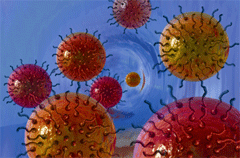
(Courtesy of Vicki Colvin)
GELLERMAN: There are a lot of big environmental stories…today we’re considering small things, very small things.
Nanotechnology. The US Commerce Department calls nanotech the next industrial revolution. Nanotechnology is the manipulation of matter at the atomic level and using the knowledge to manufacture products and develop industrial processes. The industry is relatively small right now but it’s growing fast. In just a little over a year, the number of nanotech products on the market has doubled to nearly 500. You’ll find nanotech used in skin creams, washing machines, bed-sheets and bowling balls. Nanotech has arrived. The question is are we ready for it?
Joining me from Zurich Switzerland is Professor Vicki Colvin, executive director of ICON – The International Council on Nanotechnology and head of the Center for Biological and Environmental Nanotechnology at Rice University. Professor, welcome.
COLVIN: Thanks for having me on the show.
GELLERMAN: So, I had no idea nanotech was in so many things.
COLVIN: Yeah, it’s kind of amazing because I think when this all started it was supposed to be the next big thing and we didn’t know it’s the actual thing. It’s here and we use it and it makes our lives better in some interesting ways.
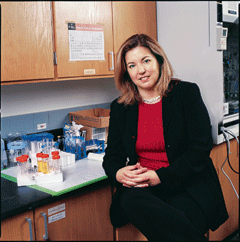
Professor Vicki Colvin is the Director of the Center for Biological and Environmental Nanotechnology at Rice University (Courtesy of Rice University Department of Media Relations)
COLVIN: Well, I’d say one product that I’m happy to use is anti-microbial toys actually that have a coating on them that resists the development of bacteria that can be damaging to my kids. So to me that’s a great trade off because anybody who has kids knows when they get sick they are pretty pitiful. If you can avoid that outcome I think that’s a great thing. So, that’s one example and another of course is sunscreens which I also use because I live in a warm climate with lots of sun. So, those are two products that I think nanaotech’s benefits are clear.
GELLERMAN: Do any of the nanotech products give you the willies?
COLVIN: Yeah, they do. You know I study, that’s part of what we think about at Rice is the sort of the good side and the other side, which is nothing great comes without its cost. You gotta think that through. So, there’s some sunscreens on the market that they have different types of nano-materials in them. I’ve thought long and hard about it. There’s a particular type that I use. I like the type that has zinc oxide in it because zinc is always good for you. It’s hard to make it not good for you even when it’s nano. And the other option is one that has titanium dioxide. And that’s just a little bit more uncertain for my tastes. It’s a personal call.
GELLERMAN: But is it the product, or the chemical, or the size that matters?
COLVIN: It is an interesting question. You know I’m a chemist, right so it all boils down to what is it? What’s the composition? What’s the stuff? Is it gold, is it carbon? So that matters. But, you know size is a very powerful parameter. I mean you can wear a silver ring and it looks silver. But if you made that same silver nano-sized you could eat it and turn yourself blue. So things are really different when they’re small. They do different stuff. And particularly in biological systems like us they can have a lot more transport, get into nooks and crannies that larger materials can’t. That’s their origin of their great power in medicine. And it’s also the thing that can give you the willies.
GELLERMAN: I think the issue is do we have federal regulations in place that can keep up with this technology.
COLVIN: Yeah, you know that’s a challenge for regulatory agencies. I mean, we all want really rapid technology. We want it to make our lives better and in large part it has. And I think that regulatory agencies have to invest in looking at new technologies and really trying to get ahead of the curve instead of behind the curve and thinking about them. And I honestly don’t know if the oversight is good enough because we actually can’t see the future yet. Certainly they’ve been cautious in regulating it. I wouldn’t say they’ve been over protective. And that means that a lot of economies and businesses have been able to develop. But the question that all of us have is you know we really hope that businesses that are profiting from these products, that they have taken to heart the great responsibility that I think they hold. If they’re profiting from this new technology that’s ahead of the curve in regulation they gotta get it right.
GELLERMAN: There are no specific nanotech laws on the books.
COLVIN: No, there are not and there’s a lot of debate in our agencies about do they need to have specific nanotech laws. I think that strikes fear in the hearts of many many people. Because nanotech while it’s new at the end of the day it’s chemicals, it’s materials. Things we, you know, we know how to think about them and evaluate their risks. I think that the challenge is that some of our assumptions about how materials interact with us, as biological systems have to be a little different when it’s small. And certainly if we built a whole big gigantic research program in this country and globally in the fact that nanotech is new and different and the materials offer us really special properties, probably some of those properties could translate into biological or environmental properties. So that’s why things like labeling become really important because then consumers, people, can make their own decisions. Because I kind of want to know, what risks am I taking. And if they’re unknown I want to know that too.

Many nanoparticles act like magnets on a miniature scale, and are the basis for developing point-of-use water purification systems in arsenic-rich areas of the world. (Courtesy of Vicki Colvin)
COLVIN: Well, Swiss Re is a fascinating company that is very forward thinking in engaging all kinds of different stakeholders in you know the general public, government, scientists like myself, other industry in conversations about risk. So, Swiss Re has been one of the cutting edge companies in understanding that you don’t want an “us vs. them” mentality. You really want to understand and create high-quality technical data. And you need to do that not just with scientists, but actually with everybody in the room. And that’s actually affected some of the research I’ve done. You know just listening to for example a woman talk about how she doesn’t want to take any risks when she uses her mascara has made me realize, “Hey, I want to know what’s in products!” I want to do the chemistry or the analytical chemistry to figure out what is in these systems and why does it work the way it does. So, Swiss Re’s focus I think is not on a particular issue. I don’t think they’re worried but I think it’s just in engaging and making sure people are talking.
GELLERMAN: Well, professor Colvin, it’s been a pleasure. Thank you very much.
COLVIN: Thank you so much.
MUSIC: Fan Modine “Mesopotamian Pop Soda” from ‘Slow Road To Tiny Empire’ (Slow River Records - 1998)
GELLERMAN: Dr. Vicki Colvin is the director of Center for Biological and Environmental Nanotechnology at Rice University. To consider more small things and hear an interview with nano-scientist Andrew Maynard of the Woodrow Wilson Center, go to our website LOE dot org.
Related links:
- Dr. Vicki Colvin's webpage
- Woodrow Wilson Center's Project on Emerging Nanotechnology
- U.S. Government's National Nanotechnology Initiative
GELLERMAN: Coming up: growing evidence linking chemicals in the environment to breast cancer in people. That’s just ahead on Living on Earth.
Cancer-Causing Chemicals

Dr. Devra Lee Davis it Professor of Epidemiology at the University of Pittsburgh's Graduate School of Public Health. (Courtesy of University of Pittsburgh)
GELLERMAN: It’s Living on Earth. I’m Bruce Gellerman. Just ahead: Eavesdrop on the globe, Google-style. But first: For years now, many activists and a growing number of scientists have been convinced that there’s a link between environmental contaminants and cancer in people—especially breast cancer.
Now that concern seems to be emerging from the margins to the mainstream. Recently, five major research institutions reviewed more than 900 scientific studies, which identified more than 200 chemicals that cause breast cancer in animals. Now, the researchers believe these chemicals, found widely in pesticides, cosmetics, dyes, drugs, gasoline and diesel exhaust, may be linked to breast cancer in humans. Their results were published online by the American Cancer Society.
Devra Lee Davis is director of the Center for Environmental Oncology at the University of Pittsburgh Cancer Institute. Dr. Davis recently spoke with Living on Earth host Steve Curwood about the connections between toxic pollutants and breast cancer.
CURWOOD: Now, how might pollution cause or promote breast cancer? What’s going on here? And what about men?
DAVIS: We know that the more hormones in a woman’s body over her lifetime, the greater the chance that she will develop breast cancer. The earlier in life she starts her period, if she has no children the more hormonal cycles she will have and the greater her risk of having breast cancer. We also know that there are a number of environmental materials that can act like hormones. And these hormone-acting or hormone-mimicking compounds can also play a role in contributing to the increased risk of breast cancer. So you have natural hormones that the body makes itself and you have synthetic agents that can act like hormones. And the combination we think is what results in breast cancer in many cases.
Because think of this: only one in ten women who develop breast cancer do so because they inherited a defective gene from their parents. That means that 9 out of 10 women who get the disease were born with healthy genes. And yet something happened to those genes in the course of a lifetime to give them breast cancer.

Dr. Devra Lee Davis it Professor of Epidemiology at the University of Pittsburgh's Graduate School of Public Health. (Courtesy of University of Pittsburgh)
DAVIS: Well, if you’re an adopted child your risk of breast cancer and other cancers parallels that of the family that you grow up in, not the one into which you were born. We know that because in Scandinavian countries they have detailed registries to follow people from birth to death. And they followed adopted children and they found this out. What we understand is that if cancer runs in your family it could be because your family had similar eating patterns, similar lifestyle patterns as well as lived in the same area.
CURWOOD: So, this report says what there are some 216 chemicals with carcinogenic properties that could be responsible for breast cancer. What sorts of chemicals are we talking about here?
DAVIS: Well, let’s first establish this: every chemical that we know for sure causes cancer in humans has been shown to cause it in animals when experimentally tested. That’s a very important fact. Now the question is, is the obverse true? Namely, is every chemical we know that causes cancer in animals – should it be regarded as though it causes cancer in humans? I happen to think yes it should. We should pay attention to these animal tests and that’s what this study of Silent Spring Institute has done.
They’ve identified 216 chemicals that are shown to cause breast cancer in animals when tested under controlled conditions. Some of the chemicals that they are talking about are very widely spread in our environment. For example 1-3 butadiene is a common air pollutant. It’s in gasoline. It’s obviously found in the urban environment wherever there are cars or trucks or busses. Benzene is a similar pollutant found in gasoline and therefore engine exhaust. Methylene chloride you may not know it but some furniture, polish some fabric cleaners, and a lot of wood sealants in the past have used methylene chloride and although it is supposed to be being phased out you don’t know whether it is in these compounds now or not.
CURWOOD: So, almost anywhere it seems then you could be exposed to a chemical that gives you breast cancer.
DAVIS: Well, let’s just say that the exposures are widespread and that’s why it’s really important that we take another look at the way we are organizing our society and the kinds of chemicals that we are using everyday. We think that there are alternatives that can be used. Here in Pittsburgh we are leading the way with green chemistry. We don’t want to wait until we have proof in humans that the chemicals that we now know cause cancer in animals will do so in humans. But in many cases we already have that evidence for some chemicals and we ought to act on the basis of what we know now to continue to reformulate and redesign our products. Big business is going to make a lot of money by doing that.
CURWOOD: Now, how do we look at 216 chemicals one at a time? How do we make sound policy out of that?
DAVIS: That is the sixty-four thousand dollar or perhaps the sixty-four million dollar question. One of the things that’s being done in Europe now is the REACH program. They are reregistering and evaluating chemical hazards by asking manufacturers to give them information that will be used to reregister and reconsider some of the highest volume chemicals in commerce today.
CURWOOD: Dr. Davis, what’s the purpose of releasing a metastudy like this, is this a call to regulators to individuals?
DAVIS: I think the purpose of this study was two things. First, was to show there was a robust and extensive literature out there; studies in animals, studies in cell cultures, and some studies in humans. The second point of this review is frankly, you have to see where it’s been published. It’s being published in the major journal of the American Cancer Society. The American Cancer Society has been somewhat slow to embrace the environment as an issue. And I think the fact that the American Cancer Society published it is really signaling a sea change in public attitudes about the environment.
CURWOOD: Why is it that while there’s a great deal of work been done to look at the link between diet and breast cancer, there’s a lot less that links environmental contaminants and breast cancer?
DAVIS: Well, there are two reasons. First, is it’s hard to do the research. It’s not easy. Life doesn’t come at you as we test it in these animals. You don’t get exposed to one chemical at a time. You are exposed to a mixture. Life is a mixture. It’s hard to study mixtures. And right now the funding for public health research is at an all time low. So, we’re not asking the question. We’re not collecting the data. It’s difficult to do it well. That’s for starters. The second reason is that if you don’t look, if you don’t ask, you can’t find it. And right now we are not asking this question. Even though it’s a hard question to ask. We don’t for example when you go into the hospital, when you go to your doctor, your doctor doesn’t ask you, “Where do you work? What chemicals do you work with? Where do you live? What’s in your drinking water? What are your good and bad habits?” Those questions are not generally asked.
CURWOOD: So, where do we go from here? There are all of these chemicals that can cause breast cancer or promote it in women. What should people take away from this news?
DAVIS: Well, there’s some good news Steve. The good news part comes from the work on nutrition. What we can do, knowing that we live in the modern world with these exposures is be vigilant about what we eat and where we live. And the way I say it is, it’s important to try to live high in the watershed, above pollution. And eat low on the food chain, which means that you want to eat foods that are low in pesticides. The fattier the food the more opportunity it has to absorb many toxic chemicals. So, having a diet that is low in animal fat is important. At this point we have no excuse not to act based on this information. But it’s not a reason for panic. It’s a reason to strengthen our resolve to make sure that we eat better and exercise, and reduce our exposures and do the same things with our families and children.
GELLERMAN: Dr. Devra Lee Davis spoke with Living on Earth host Steve Curwood. She is director of the Center for Environmental Oncology at the University of Pittsburgh Cancer Institute. Her new book is called “The Secret History of the War on Cancer.”
Related link:
Silent Spring Institute's link to the report
REACHing for Regs
GELLERMAN: Well, concerns in Europe about chemicals have led to a new law that just went into effect there. It’s called REACH --- short for: Registration, evaluation, authorization and restriction of chemicals. And the European Union law is certainly far-reaching and controversial. For the first time, makers of more than 30 thousand chemicals must test and prove their substances, and the products they’re used in, are safe for people and the environment. The law also applies to US companies that export chemicals to the EU. The American Chemistry Council –which represents US manufacturers-- opposed the 800 page long regulation charging it was overly complex and costly. But Steve Russell of the Chemistry Council says the law is the law.
RUSSELL: At the moment US companies are working very hard to make sure they’re prepared to comply with REACH. We think the jury is still out on whether it will deliver its anticipated benefits, at least in the way that its proponents anticipate.
GELLERMAN: Proponents here say we should have something like REACH, too, because current U.S. chemical regulations are largely voluntary. Still, Joel Tickner, a professor of environmental health at University of Massachusetts- Lowell, thinks the European law will change the way American companies do business in the U.S.
TICKNER: I think it will have a positive effect ultimately. It’s going to force companies to start thinking about how to design safer chemicals, and to think about the toxicity of chemicals that have essentially been allowed to be used for the past 40 years without any regulation.
GELLERMAN: The US exports 14 billion dollars of chemicals to Europe each year complying with the new EU law is estimated to cost 14 million dollars annually.
MUSIC: Lullaby Baxter “Jet-Pack” from ‘Garden Cities of To-morrow’ (Boompa - 2006)
Related links:
- European Union's website for its new regulatory law REACH
- American Chemistry Council health page
Google Earth Finds its Voice
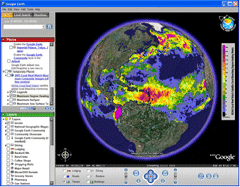
Typical Google Earth Screen (Courtesy of NOAA)
GELLERMAN: Log on to Google Earth and you get a bird’s eye view of the globe. That is if the bird is a high-flying satellite able to see everything from the Great Wall of China to the car in your driveway. But you might want to pull down your window shades because Google has started offering street level views that allow you to peek inside buildings. Still, Google software is a great way to see the planet. And now you can use it to hear the Earth, as well.
[SONOMOA VALLEY SUNRISE]
This is what sunrise in Sonoma Valley, California sounds like. Dr. Bernie Krause recorded it. It’s one of over 1200 locations he’s recorded over a 40-year career. Dr. Krause is a bio-acoustician and president of Wild Sanctuary, an online audio archive. He recently teamed up with Google Earth to add sound to their service and he joins me from a studio in California. Dr. Krause, welcome.
KRAUSE: Thank you, Bruce.
GELLERMAN: Boy, who knew it was such a racket in Sonoma Valley, California.
KRAUSE: Can you believe that? This is one of those rare spots in Sonoma Valley that hasn’t been developed for wine and grapes. And it’s particularly beautiful because it’s one of those places that sounds like the earth sounded like 150 or 200 years ago.
GELLERMAN: Well, how does your work, your recordings, work with Google Earth? How do you add sound to a map?
KRAUSE: Well, if you can imagine the map, and when you zoom into Google Earth you zoom in from outer space to a point. And typically what happens is it looks like a silent movie. There’s this big globe out there and you move into a spot, and I began to layer sounds to these spots and it became so engaging we just thought, well maybe we should really try and approach Google and see if they’d be interested in adding it as a layer to their material.

Typical Google Earth Screen (Courtesy of NOAA)
KRAUSE: Well, what you would do is when it gets up, you go to the lower left hand part of the page and you’ll click a little box that will say soundscape. And when that box is checked as you’re zooming into that spot the sound will get louder and louder and louder to the point where when you’re a couple of thousand feet above that particular site you’ll hear the full range of sound.
GELLERMAN: So, I’m going to zoom over to Corcovado National Park in Costa Rica and let’s listen to what we get.
[HOWLER MONKEYS AND TREE FROG CALLS]
GELLERMAN: What is that Dr. Krause?
KRAUSE: Well, in the background you’re hearing a howler monkey. And then you’re hearing little tree frogs, little peepers, and some insects.
GELLERMAN: When did you make this?
KRAUSE: This was made in the early 90’s and it was a very special place then. It’s gone through some radical changes since global warming. And many of these sounds can’t be heard anymore. As a matter of fact, Bruce, 40 percent of my library that I’ve collected is from now extinct habitats or habitats so radically altered that you can’t hear those distinct sounds anymore.
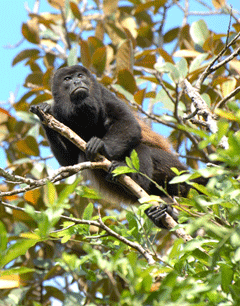
A male mantled howler monkey in Costa Rica. (Photo: Leonardo C. Fleck.)
KRAUSE: Yes, I have before and after effects from many places on the planet, certainly not all of them but several of them.
GELLERMAN: Well, we have a recording here from Lincoln Meadow in the Sierra Mountains in California. Can you tell me what’s going on?
KRAUSE: Yeah, this is a recording that was made in 1988 in Lincoln Meadow, which is about 40 miles north of Truckee. The issue was raised by the logging companies whether or not there was going to be any effect as a result of selective logging. And they informed us that there wasn’t. There was going to be no biological effect. And sure enough when you go out there into the forest and you look at this beautiful meadow it looks absolutely gorgeous. And the same thing after. I mean to the human eye there is no change at all. But let’s listen to the sounds of this place. This is the before sound.
[SEVERAL VARIETIES OF BIRD CALLS]
GELLERMAN: Wow, that’s really beautiful.
KRAUSE: It’s so rich. And it’s got density and diversity to it.
GELLERMAN: Ok, let’s listen to the after.
[SOUND OF RUNNING WATER]
KRAUSE: This is a year later and 15 years hence it’s exactly the same.
GELLERMAN: You’re missing all the richness though.
KRAUSE: There’s nothing there. Now to the eye it looks absolutely the same. But the ear tells the truth. I like to say that you know a picture is worth a thousand words and a soundscape is worth a thousand pictures.
GELLERMAN: Now if I go to Google Earth can I hear the before and after?
KRAUSE: You will be able to hear the before and after because we plan on using that as one of the layers.
GELLERMAN: So, what you actually have are audio artifacts. These are things that no one will hear in the future.
KRAUSE: That’s correct. But you know, I’m ever hopeful, I’m an optimist. I believe that by bringing these things to people’s attention through things like Google Earth that they’re going to want to pay some more attention to it and just get out into the natural world and enjoy it for what it is. Because it’s one of those things that’s really an analgesic. It helps heal us.
GELLERMAN: Now, your recordings are not limited to just natural sounds from the environment. Am I right?
KRAUSE: That’s correct.
GELLERMAN: You also have sound of cities?
KRAUSE: Yes, we do and one of the things about Google Earth that was really interesting when we began to formulate sounds of these various places like for instance Lisbon, or Paris, or London, or New York each of them has their own sound signature. And it’s remarkable how different these places sound.
GELLERMAN: Let’s listen to Lisbon.
LOCAL MUSIC AND PEOPLE TALKING, MUSIC IN THE BACKGROUND
GELLERMAN: Do you remember recording it?
KRAUSE: Oh, sure. It was down near the Tagus River. I was just walking down the street with mikes on my shoulder so people wouldn’t notice it and just picked up the soundscape, same way I do pretty much all over cities in the world.
GELLERMAN: What’s the strangest place you’ve ever gone to record sounds?
KRAUSE: Wow, what a question. Nobody’s ever asked it that way, Bruce. Well, I guess it would be a tide pool in Alaska where we recorded anemones.
GELLERMAN: Anemones make sound?
KRAUSE: They sing.
[SEA ANEMONE SOUNDS]
KRAUSE: What we did is we dropped a hydrophone down the mouthpart, the center part of the anemone. And then the tentacles, you’re hearing the tentacles wrap around it, those gentle little clicking sounds because it’s looking for something of nutritional value. And then when it finds nothing of nutritional value you hear:
[ANEMONE HONKING SOUND]
KRAUSE: It sounds like a belch.
GELLERMAN: Now, you’ve listened to these tapes over and over again. Do you get something different when you listen to them and view Google Earth?
KRAUSE: Oh, there’s no question about it because it brings that Google Earth experience to life. It gives it life and that’s the one thing that soundscapes do.
GELLERMAN: So, Dr. Krause, before I let you go let’s listen to one more piece of sound. What do you got?
KRAUSE: Well, we’ve got one that was recorded by a colleague of mine, Ruth Happel at a place called Echo Pond in the Adirondacks.
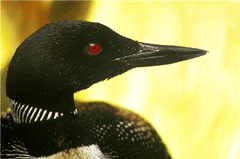
Common Loon (Courtesy of U.S. National Park Service)
[SOUND OF LOON CALLS]
GELLERMAN: Boy, those loons sound ethereal.
KRAUSE: It’s one of the most haunting sounds on the planet. And when you hear these loons, the common loons and the arctic loons it just brings tears to your eyes but at the same time it makes you feel so good to be there.
GELLERMAN: Well, Dr. Krause, I’ve really enjoyed speaking to you.
KRAUSE: Thanks, it’s been a pleasure.
GELLERMAN: To hear Dr. Krause’s sounds for yourself, you can download the Google Earth software on our website loe.org.
Related links:
- Download Google Earth
- Download the soundscape layer for Google Earth
- Read more about the effects of climate change on Corcovado National Park
Coming up: the invisible glue that holds the cosmos together: the mystery of dark matter. Keep listening to Living on Earth.
Cosmic Quandaries
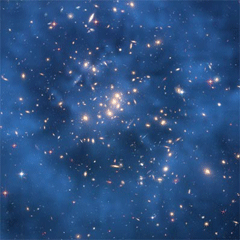
A composite image from the Hubble Space Telescope shows a phantom "ring" of dark matter in the galaxy cluster ZwC10024+1652. (Courtesy of NASA, ESA, M.J. Jee and H. Ford et al. (John Hopkins U.))
GELLERMAN: It’s Living on Earth. I’m Bruce Gellerman. Just ahead: music to the ears for geologists. But first: When it comes to the universe seems, we ain’t seen nothing yet. That’s because astrophysicists estimate 95 percent of the cosmos can’t be seen. It’s invisible. They call the mysterious stuff “dark matter.” But now, astronomers using the Hubble telescope have detected a shadowy ring inside a cluster of galaxies they believe might be the first glimpse of dark matter. Like pebbles in a pond, the ghostly ring is evidence that something big and powerful is affecting the galaxies…only we can’t see it directly.
Well, when things astronomical leave us in the dark, we call upon Neil deGrasse Tyson.
Dr. Tyson is director of the Hayden Planetarium in New York City and author of the new book “Death by Black Hole and Other Cosmic Quandaries.” So, Dr. Tyson can you shed some light just what is dark matter?
TYSON: We have no idea. Well, that’s not true. We have some ideas but none of them have any experimental foundation yet. Dark matter is a little bit misnamed. We should probably think of it as dark gravity because there is a source of gravity out there whose point of origin remains a mystery. So it’s really dark gravity.
GELLERMAN: So, how do we know that it’s out there?
TYSON: Because we see massive systems of galaxies where if you add up all of the matter in the galaxies, even stars, gas clouds and even black holes, add it all up and account for the gravity it should have. It is a fraction of the total gravity exhibited in the entire cluster.
GELLERMAN: So, how is dark matter then different from regular matter?
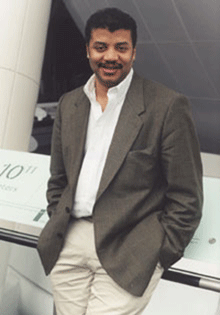
Neil deGrasse Tyson is director of New York’s Hayden Planetarium (Courtesy of Patrick Queen© Reprinted by permission of Prometheus Books)
GELLERMAN: I’ve heard that WIMPS might be dark matter.
TYSON: Yeah, that’d be weakly interactive massive particles. Massive in this case would be sort of high mass when compared with a particle, not compared with a galaxy. And so that’s just an acronym to contain our ignorance of what it might be suggesting that it’s some kind of particle that doesn’t interact with our particles and in that way would be completely invisible to us.
GELLERMAN: So, the weak may inherit the earth but it’s the wimps who get the universe.
MUSIC: The Tornadoes “Life On Venus” from “Vampires, Cowboys, Spacemen And Spooks: The Very Best Of Joe Meek’s Instrumentals’ (Rykodisk – 2007)
TYSON: (laughs)
GELLERMAN: You think wimps are weird how about life on other planets? Well, 12 years ago scientists discovered the first planet outside our solar system revolving around another star and since then they’ve catalogued over 300 more. The latest of these so-called exo-planets was recently discovered and Dr. Tyson says this one looks a lot like planet Earth.
TYSON: Here’s the challenge: the planet itself at those distances is so small, so dim, we don’t see them directly. They’re discovered by observing the effect of their gravity on the host star, which does show up in your telescopes. We see their effect on the host star. And so the catalogue is filled with planets that are like the size of Jupiter and bigger. And we’re not thinking that life as we know it would thrive on a Jupiter, maybe on a Jupiter moon but not on a Jupiter. And so the holly grail out there has been, ‘can we find a planet that resembles earth?’ And just recently one such planet was discovered.
GELLERMAN: What’s it called?
TYSON: There’s a catalogue of nearby stars that are kind of sun-like and it’s called the Gliese Catalogue G-L-I-E-S-E Gliese Catalogue and this is one of the stars in that catalogue. And this is one of the stars in that catalogue. Ands so it’s named for that catalogue, so it’s Gliese 581-C is the name of the planet.
GELLERMAN: So, what are the odds that it has life on it?
TYSON: Oh, what I left out is, ok it’s great that you find planets but what really matters is you want to know how far from the host’s star is it? If it’s too close if there were any water on the planet it would evaporate. If it’s too far from the host planet, it would freeze. And life as we know it requires liquid water. So there’s this Goldilocks zone in the vicinity of every star out there. The sun has a Goldilocks zone they all do. This earth-like planet was discovered orbiting the Goldilocks zone of that host star. So, if it’s going to have life as we know it it’s a pretty good chance of it given its location.

A composite image from the Hubble Space Telescope shows a phantom "ring" of dark matter in the galaxy cluster ZwC10024+1652. (Courtesy of NASA, ESA, M.J. Jee and H. Ford et al. (John Hopkins U.))
TYSON: Well, you know I can give it to you in miles and it will sound impossibly far, which it is, except it’s one of the closest stars to us in whole the galaxy. So, it’s a reminder of how vast space is and the galaxy is and the rest of the cosmos is. It’s about 20 light years away.
GELLERMAN: Oh, well, that’s right around the corner.
TYSON: I know but if you put that in miles it’s like 120 trillion miles. So it would take you (muttering calculations) it would take you 300,000 years to get there going on the fastest spaceships ever built.
GELLERMAN: How would they detect if there were life on this planet? How would we know?
TYSON: Excellent question. Well, if there’s intelligent life with technology you can imagine just beaming radio signals there because radio will get there in 20 years at the speed of light, radio waves is a form of light. And if it’s 20 light years away, it takes 20 years for the signal to get there. So you send it some signal saying, “Hi, how are you doing? We’re over here. Here’s some stuff we learned about our place in the universe.” And then they would receive it and maybe send a reply. And so this would not be a sort of witty repartee because a roundtrip conversation takes 40 years. But that could work. But another way to discover life is an emerging field called the search for biomarkers. On earth we have oxygen in our atmosphere and oxygen is a sign that there’s life on earth. If you took away life the oxygen would all go away. So would the methane. There are certain molecules that are only kept there by the action of life. So, as you look to other planets you’re going to look for oxygen. You’re going to look for methane. So these are biomarkers. Another fascinating biomarker might be smog. I don’t know if that’d be a sign of intelligence or not, but it certainly would be a sign of life.
GELLERMAN: Well, Dr. Tyson, it’s been a real pleasure. I enjoyed it a lot.
TYSON: Thanks, thanks for having me.
GELLERMAN: Astrophysicist Neil Tyson regularly explores the cosmos for Living on Earth and hosts the PBS TV series: “Nova Science Now.” So, let’s say there is life on Gleise 581 C and let’s say they’re tuning in to Earth right now from 20 light years away. They’d just be receiving broadcasts from 1987: that’s the year wrestle mania set a record for indoor attendance at a sporting event, Prozac made its debut in drug stores, the world’s first conference on artificial life was held, and Michael Jackson was doing the moon walk. It was an interesting year.
MUSIC: GLIESE 581 C MONTAGE: Clips in order of Appearance…
1.) Michael Jackson “BAD” from ‘1987 World Tour’ (Tokyo, Japan - 1987)
2.) Oliver North “Iran-Contra Scandal” Shredding Quote (1987)
3.) Gunnery Sergeant Hartman “Full Metal Jacket” by Stanley Kubrick Film Clip (Warner Bros. Pictures - 1987)
4.) Public Enemy “You’re Gonna Get Yours” from ‘Yo! Bum Rush The Show’ (Def Jam Records – 1987)
5.) Ronald Reagan “Tear Down This Wall” Speech (Berlin Wall, West Germany - 1987)
6.) Los Angeles Lakers NBA Champions (Los Angeles Lakers Stadium - 1987)
7.) SEGA Master System Video Game TV Commercial (Sega Corp. - 1987)
8.) The David Letterman Show “Stupid Pet Tricks” (NBC TV – 1987)
9.) Michigan TV Newscast “Ford Motor Company Profits” (WJBK2 TV - 1987)
10.) Yogurt “Spaceballs” by Mel Brooks Film Clip (MGM/UA - 1987)
GELLERMAN: 1987, as heard on exo-planet Gleise 581 C today.
Related links:
- More information on the dark matter "ring"
- More information on Exoplanet Gliese 581 c
Geophonic Music
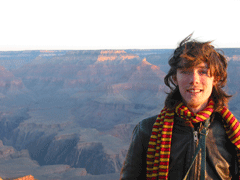
Arvid Tomayko-Peters in front of the Grand Canyon (Courtesy of Arvid Tomayko-Peters)
GELLERMAN: Well, twenty years from now Gleicians might be hearing this:
MUSIC: Arvid Tomayko-Peters “Vostok Blues”
GELLERMAN: This duet is composed from climate change records: data about carbon dioxide and ice temperatures put to music. Arvid Tomayko-Peters transforms geological data into sound using a computer program he created.
TOMAYKO-PETERS: In Geology, you have these layers stacked, one on top of the other and each one of them is a little bit different, so I approach this sort of like a score in music.
GELLERMAN: Arvid Tomayko-Peters just graduated from Brown University with a dual degree in computer music and geology. As part of his senior thesis he created the geo-music software. Living on Earth’s Ian Gray visited Arvid’s studio and produced this audio portrait.
[MUSIC PLAYING]
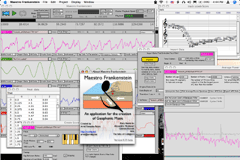
Maestro Frankenstein: the software program that Arvid Tomayko-Peters' created to write his music.
(Courtesy of Arvid Tomayko-Peters)
TOMAYKO-PETERS: Then I started to write this meistrofranksnstein software, which is a multi track sequencer for scientific data instead of music.
[MUSIC: POND CORE METAL]
TOMAYKO-PETERS: What we’re listening to is abundances of different elements then a column of mud from the bottom of a pond in Rhode Island. There’s twelve metals that we found in this mud that we’re concerned about such as chromium, arsenic and lead. Each metal is like a finger on a piano key. So in this case we have twelve fingers. You can see sort of at the end of the piece that a lot of the pitches get lower. That is an indication of less pollution because of less industry back 150 years ago when that sediment was laid down.
[KEYBOARD TAPPING]

Arvid Tomayko-Peters in front of the Grand Canyon(Courtesy of Arvid Tomayko-Peters)
[MUSIC: VOSTOK BLUES]
TOMAYKO-PETERS: So the string instrument that you’re hearing is the amount of carbon dioxide. And the tinkly xylophone-like synthesized instrument is the amount of ice. So the two instruments play opposite one another. When one is going down the other is going up through several ice ages. The time period that I’m going to play is the time that Homo sapiens has been in existence, the last about 195,000 years.
[MUSIC: VOSTOK BLUES CONTINUES]
TOMAYKO-PETERS: Now when the stringed instrument, carbon dioxide increases, there’s not very much ice. And when the pitch of this xylophone-like instrument is higher, there’s more ice on the poles. The data that I’m using here shows this really tight correlation between the amount of carbon dioxide and the amount of ice at the poles on the earth.
The latest piece I’ve been putting a lot of work into was an interactive installation, where visitors would come in and hear eight deep ocean cores being played back as sound. And it’s a very sort of ethereal piece. You come in, you listen and there’s no notes. Everything is continuous tone and just constantly changing pitch.
[MUSIC: CLIMATE CONTROL EXHIBIT]
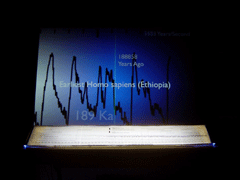
Arvid Tomayko-Peters most recent project turned data from eight deep-ocean sediment cores into an experimental geo-music exhibition. A giant screen tracked data going back 5.3 millions years and flashed events from Earth's history that corresponded to the chronology of the data--like the birth of Homo Sapiens 188,858 years ago.
(Courtesy of Arvid Tomayko-Peters)
[CLIMATE CONTROL CONTINUES]
TOMAYKO-PETERS: One of the wonderful things I think this music gives a listener a chance to do is relate to and experience this inconceivably long amount of geologic time that there have been. I mean a million years, you can’t even imagine that. And that’s just a tiny portion of the earth’s history going back 4.5 billion years. So, if you condense it down to something where you can experience that time in thirty seconds or five minutes it just sort of brings that time frame home, and makes you realize how absolutely short your existence is.
[MORE GEOLOGIC SOUNDS]
GELLERMAN: Our portrait of Arvid Tomayko-Peters was produced by Living on Earth’s Ian Gray.
Related link:
Tomayko Peters' website
GELLERMAN: Next week on Living on Earth: In our closets are three and a half billion wire hangers put them together they’d stretch from the Earth to the moon nine times, put them into landfills and you have 200 million pounds of steel. A new company says hang up the wire –recycled paper is the way to go.
KANTOR: Virtually the only reason that anyone would ever want to have a wire hanger again is to either keep your muffler on, or break into your car.
GELLERMAN: Hangers that suit the environment next time on Living on Earth.
ARCTIC ICE CREAKS
We leave you this week with some very cool rhythms.
GELLERMAN: In the Arctic Ocean, ice floes frequently collide. As they buckle and slide over one another, they sound like this.
LOUD ICE CREAKS
Robert Asher recorded these frozen sheets near the Canadian Abyssal Plain.
GELLERMAN: Living on Earth is produced by the World Media Foundation. Our crew includes Ashley Ahearn, Eileen Bolinsky, Ian Gray, Ingrid Lobet, Jennifer Percy, Emily Taylor, Peter Thomson and Jeff Young - with help from Bobby Bascomb, and Kelley Cronin. Our interns are Lauren Cox and Amy Fish.
Dennis Foley is our technical director. Our executive producer is Steve Curwood. Alison Lirish Dean composed our themes. You can find us at LOE dot org. I’m Bruce Gellerman.
Thanks for listening.
ANNOUNCER: Funding for Living On Earth comes from the National Science Foundation, supporting coverage of emerging science, and Stonyfield Farm: Organic yogurt, smoothies and milk. Ten percent of profits are donated to efforts that help protect and restore the earth. Details at Stonyfield dot com.
Support also comes from you our listeners, the Ford Foundation, the Town Creek Foundation, and the Saunders Hotel Group of Boston's Lennox and Copley Square Hotels. Serving you and the environment while helping preserve the past and protect the future, 800-225-7676.
Living on Earth wants to hear from you!
Living on Earth
62 Calef Highway, Suite 212
Lee, NH 03861
Telephone: 617-287-4121
E-mail: comments@loe.org
Newsletter [Click here]
Donate to Living on Earth!
Living on Earth is an independent media program and relies entirely on contributions from listeners and institutions supporting public service. Please donate now to preserve an independent environmental voice.
NewsletterLiving on Earth offers a weekly delivery of the show's rundown to your mailbox. Sign up for our newsletter today!
 Sailors For The Sea: Be the change you want to sea.
Sailors For The Sea: Be the change you want to sea.
 The Grantham Foundation for the Protection of the Environment: Committed to protecting and improving the health of the global environment.
The Grantham Foundation for the Protection of the Environment: Committed to protecting and improving the health of the global environment.
 Contribute to Living on Earth and receive, as our gift to you, an archival print of one of Mark Seth Lender's extraordinary wildlife photographs. Follow the link to see Mark's current collection of photographs.
Contribute to Living on Earth and receive, as our gift to you, an archival print of one of Mark Seth Lender's extraordinary wildlife photographs. Follow the link to see Mark's current collection of photographs.
 Buy a signed copy of Mark Seth Lender's book Smeagull the Seagull & support Living on Earth
Buy a signed copy of Mark Seth Lender's book Smeagull the Seagull & support Living on Earth

